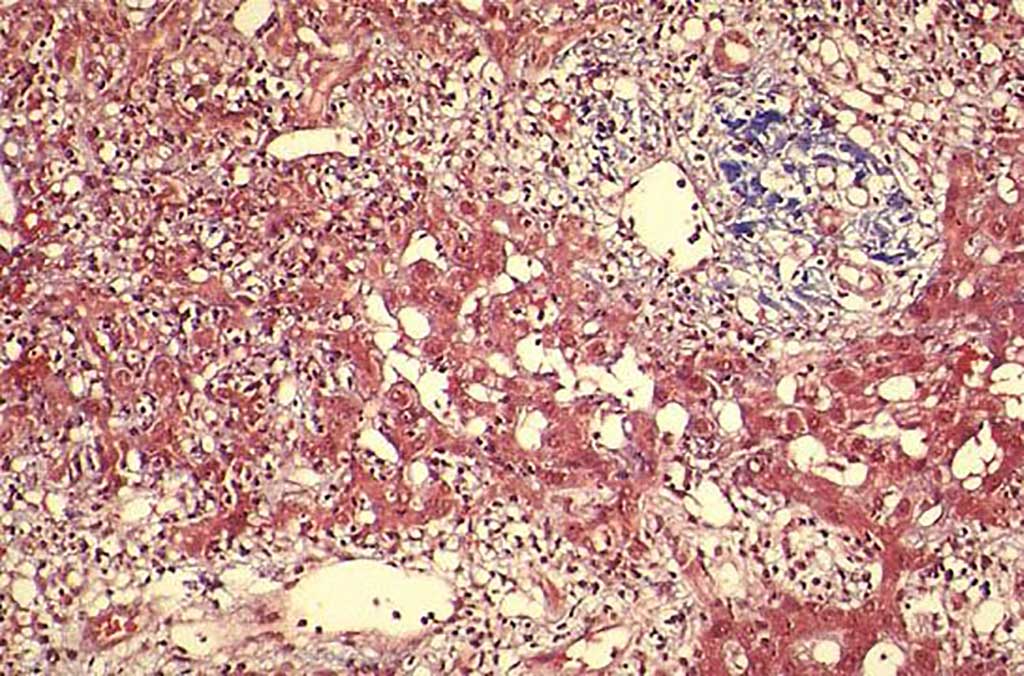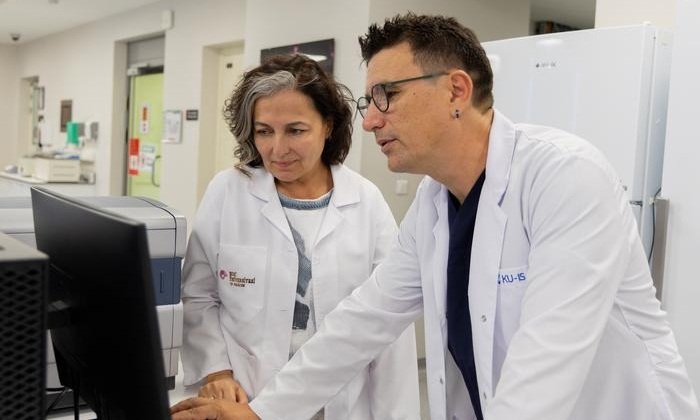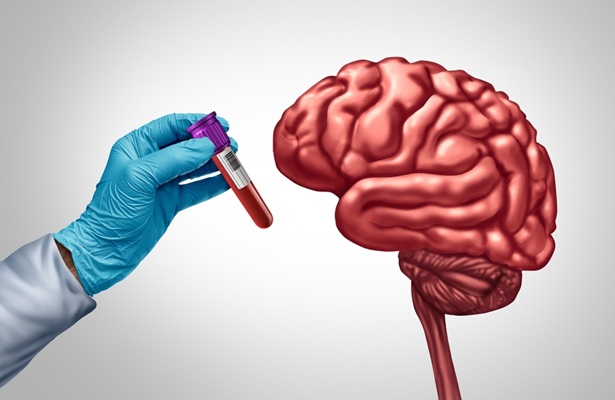HDL-Cholesterol Predicts Survival in Cirrhotic Patients with Gastrointestinal Bleeding
|
By LabMedica International staff writers Posted on 10 Dec 2020 |

Image: Histopathology of a cirrhotic liver. High-density lipoprotein cholesterol predicts survival in cirrhotic patients with acute gastrointestinal bleeding (Photo courtesy of Loyola University Chicago).
Liver cirrhosis is an important cause of morbidity and mortality as a consequence of continuous liver injuries. Acute gastrointestinal bleeding is a serious complication and critical clinical event in cirrhotic patients. Hepatitis B virus (HBV) is the leading cause of liver cirrhosis in China.
Since the liver plays a crucial role in cholesterol homeostasis, hypercholesterolemia often occurs in patients with chronic liver diseases. The decrease in serum levels of lipids and lipoproteins is highly prevalent in cirrhotic patients, with a prevalence that increases in parallel with the disease severity.
Infectious disease specialists at the Peking University First Hospital (Beijing, China) evaluated from January 2008 to December 2015, consecutive cirrhotic patients with acute gastrointestinal bleeding who were randomly divided into the derivation (n = 629) and validation (n = 314) cohorts. Liver cirrhosis was confirmed either by liver biopsy or by clinical presentations, routine liver function tests and medical imaging techniques. A logistic regression model was established to confirm the association between lipoprotein cholesterol and mortality. Routine biochemical tests were performed in the hospital laboratory. Lipid profiles include triglyceride, cholesterol, high-density lipoprotein cholesterol (HDL-C) and low-density lipoprotein cholesterol (LDL-C).
The investigators reported that on ROC analysis, HDL-C showed excellent diagnostic accuracy for six-week mortality, with an area under the receiver operating characteristic curves (AUROC) of 0.847 (95% CI 0.789–0.905). The best cut-off value of HDL-C was 0.54 mmol/L, with a sensitivity of 85.1% and specificity of 74.2%. The laboratory variables significantly associated with 6-week mortality in the univariate analysis were as follows: hepatocellular carcinoma (HCC), packed red blood cells (PRBC) transfusion, hemoglobin (HGB), total leukocyte count (WBC), alanine aminotransferase (ALT), serum sodium (Na), total bilirubin (TBIL), albumin (ALB), cholesterol, HDL-C, LDL-C, serum creatinine (Scr), international normalized ratio (INR), fibrinogen (FIB). Multivariate logistic regression analyses showed that TBIL, HDL-C, Na, and HGB were independently associated with six-week mortality.
The authors concluded that HDL-C is a potential indicator for the prognosis of patients with cirrhosis and acute gastrointestinal bleeding. The new algorithm based on HDL-C allowed an accurate predictive assessment of 6-week mortality after bleeding attack. The study was published on November 16, 2020 in the journal BMC Gastroenterology.
Related Links:
Peking University First Hospital
Since the liver plays a crucial role in cholesterol homeostasis, hypercholesterolemia often occurs in patients with chronic liver diseases. The decrease in serum levels of lipids and lipoproteins is highly prevalent in cirrhotic patients, with a prevalence that increases in parallel with the disease severity.
Infectious disease specialists at the Peking University First Hospital (Beijing, China) evaluated from January 2008 to December 2015, consecutive cirrhotic patients with acute gastrointestinal bleeding who were randomly divided into the derivation (n = 629) and validation (n = 314) cohorts. Liver cirrhosis was confirmed either by liver biopsy or by clinical presentations, routine liver function tests and medical imaging techniques. A logistic regression model was established to confirm the association between lipoprotein cholesterol and mortality. Routine biochemical tests were performed in the hospital laboratory. Lipid profiles include triglyceride, cholesterol, high-density lipoprotein cholesterol (HDL-C) and low-density lipoprotein cholesterol (LDL-C).
The investigators reported that on ROC analysis, HDL-C showed excellent diagnostic accuracy for six-week mortality, with an area under the receiver operating characteristic curves (AUROC) of 0.847 (95% CI 0.789–0.905). The best cut-off value of HDL-C was 0.54 mmol/L, with a sensitivity of 85.1% and specificity of 74.2%. The laboratory variables significantly associated with 6-week mortality in the univariate analysis were as follows: hepatocellular carcinoma (HCC), packed red blood cells (PRBC) transfusion, hemoglobin (HGB), total leukocyte count (WBC), alanine aminotransferase (ALT), serum sodium (Na), total bilirubin (TBIL), albumin (ALB), cholesterol, HDL-C, LDL-C, serum creatinine (Scr), international normalized ratio (INR), fibrinogen (FIB). Multivariate logistic regression analyses showed that TBIL, HDL-C, Na, and HGB were independently associated with six-week mortality.
The authors concluded that HDL-C is a potential indicator for the prognosis of patients with cirrhosis and acute gastrointestinal bleeding. The new algorithm based on HDL-C allowed an accurate predictive assessment of 6-week mortality after bleeding attack. The study was published on November 16, 2020 in the journal BMC Gastroenterology.
Related Links:
Peking University First Hospital
Latest Clinical Chem. News
- Noninvasive Blood-Glucose Monitoring to Replace Finger Pricks for Diabetics
- POC Breath Diagnostic System to Detect Pneumonia-Causing Pathogens
- Online Tool Detects Drug Exposure Directly from Patient Samples
- Chemical Imaging Probe Could Track and Treat Prostate Cancer
- Mismatch Between Two Common Kidney Function Tests Indicates Serious Health Problems
- VOCs Show Promise for Early Multi-Cancer Detection
- Portable Raman Spectroscopy Offers Cost-Effective Kidney Disease Diagnosis at POC
- Gold Nanoparticles to Improve Accuracy of Ovarian Cancer Diagnosis
- Simultaneous Cell Isolation Technology Improves Cancer Diagnostic Accuracy
- Simple Non-Invasive Hair-Based Test Could Speed ALS Diagnosis
- Paper Strip Saliva Test Detects Elevated Uric Acid Levels Without Blood Draws
- Prostate Cancer Markers Based on Chemical Make-Up of Calcifications to Speed Up Detection
- Breath Test Could Help Detect Blood Cancers
- ML-Powered Gas Sensors to Detect Pathogens and AMR at POC
- Saliva-Based Cancer Detection Technology Eliminates Need for Complex Sample Preparation
- Skin Swabs Could Detect Parkinson’s Years Before Symptoms Appear
Channels
Molecular Diagnostics
view channel
World's First NGS-Based Diagnostic Platform Fully Automates Sample-To-Result Process Within Single Device
Rapid point-of-need diagnostics are of critical need, especially in the areas of infectious disease and cancer testing and monitoring. Now, a direct-from-specimen platform that performs genomic analysis... Read more
Rapid Diagnostic Breakthrough Simultaneously Detects Resistance and Virulence in Klebsiella Pneumoniae
Antibiotic resistance is a steadily escalating threat to global healthcare, making common infections harder to treat and increasing the risk of severe complications. One of the most concerning pathogens... Read moreHematology
view channel
MRD Tests Could Predict Survival in Leukemia Patients
Acute myeloid leukemia is an aggressive blood cancer that disrupts normal blood cell production and often relapses even after intensive treatment. Clinicians currently lack early, reliable markers to predict... Read more
Platelet Activity Blood Test in Middle Age Could Identify Early Alzheimer’s Risk
Early detection of Alzheimer’s disease remains one of the biggest unmet needs in neurology, particularly because the biological changes underlying the disorder begin decades before memory symptoms appear.... Read more
Microvesicles Measurement Could Detect Vascular Injury in Sickle Cell Disease Patients
Assessing disease severity in sickle cell disease (SCD) remains challenging, especially when trying to predict hemolysis, vascular injury, and risk of complications such as vaso-occlusive crises.... Read more
ADLM’s New Coagulation Testing Guidance to Improve Care for Patients on Blood Thinners
Direct oral anticoagulants (DOACs) are one of the most common types of blood thinners. Patients take them to prevent a host of complications that could arise from blood clotting, including stroke, deep... Read moreImmunology
view channel
Blood Test Could Identify Colon Cancer Patients to Benefit from NSAIDs
Colon cancer remains a major cause of cancer-related illness, with many patients facing relapse even after surgery and chemotherapy. Up to 40% of people with stage III disease experience recurrence, highlighting... Read moreBlood Test Could Detect Adverse Immunotherapy Effects
Immune checkpoint inhibitors have transformed cancer treatment, but they can also trigger serious immune-related adverse events that damage healthy organs and may become life-threatening if not detected early.... Read moreMicrobiology
view channel
New UTI Diagnosis Method Delivers Antibiotic Resistance Results 24 Hours Earlier
Urinary tract infections affect around 152 million people every year, making them one of the most common bacterial infections worldwide. In routine medical practice, diagnosis often relies on rapid urine... Read more
Breakthroughs in Microbial Analysis to Enhance Disease Prediction
Microorganisms shape human health, ecosystems, and the planet’s climate, yet identifying them and understanding how they are related remains a major scientific challenge. Even with modern DNA sequencing,... Read morePathology
view channel
AI Tool Simultaneously Identifies Genetic Mutations and Disease Type
Interpreting genetic test results remains a major challenge in modern medicine, particularly for rare and complex diseases. While existing tools can indicate whether a genetic mutation is harmful, they... Read more
Rapid Low-Cost Tests Can Prevent Child Deaths from Contaminated Medicinal Syrups
Medicinal syrups contaminated with toxic chemicals have caused the deaths of hundreds of children worldwide, exposing a critical gap in how these products are tested before reaching patients.... Read more
Tumor Signals in Saliva and Blood Enable Non-Invasive Monitoring of Head and Neck Cancer
Head and neck cancers are among the most aggressive malignancies worldwide, with nearly 900,000 new cases diagnosed each year. Monitoring these cancers for recurrence or relapse typically relies on tissue... Read moreTechnology
view channel
Diagnostic Chip Monitors Chemotherapy Effectiveness for Brain Cancer
Glioblastoma is one of the most aggressive and fatal brain cancers, with most patients surviving less than two years after diagnosis. Treatment is particularly challenging because the tumor infiltrates... Read more
Machine Learning Models Diagnose ALS Earlier Through Blood Biomarkers
Amyotrophic lateral sclerosis (ALS) is a rapidly progressive neurodegenerative disease that is notoriously difficult to diagnose in its early stages. Early symptoms often overlap with other neurological... Read moreIndustry
view channel
BD and Penn Institute Collaborate to Advance Immunotherapy through Flow Cytometry
BD (Becton, Dickinson and Company, Franklin Lakes, NJ, USA) has entered into a strategic collaboration with the Institute for Immunology and Immune Health (I3H, Philadelphia, PA, USA) at the University... Read more









 Analyzer.jpg)












